
According to statistics, moles on the head occur in every 20 people on the planet. This is a common phenomenon, but not everyone knows what moles are, whether they are dangerous, how to care for them and whether they should be removed. You will find answers to all these questions in our article.
Why do moles appear?
A mole is the most common formation on the body; each person can have several dozen small and large nevi. Their appearance, including on the head under the hair, is possible for the following reasons:
— Incorrect division of epidermal cells during fetal development in the womb. In this case, the newborn may already have moles on his body.
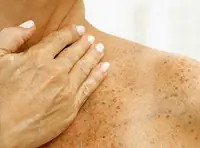
- Excessive exposure to ultraviolet rays. This is one of the most common reasons for the appearance of moles, since many people like to vacation in hot countries and do not always take care of protecting their skin. Aggressive exposure to sunlight can lead to rapid growth of moles, especially in areas with delicate and thin skin.
— Heredity. Due to genetic characteristics, some moles that parents have can be passed on to their children. Most often, such nevi are congenital.
— Hormonal imbalance in the body. Moles on the head can appear during puberty, pregnancy or menopause. At this time, hormonal levels are disrupted and the body is rebuilt, which gives impetus to the emergence of new formations.
- Injuries. It is extremely rare, however, that damage to the skin on the body or head can cause a mole to appear in that area.
Most often, moles do not cause inconvenience and are benign. However, much may depend on their location.
Types of moles on the head
1. Large mole
Most often, this is a congenital neoplasm that grows with a person and in some cases can reach 10 cm. Such moles are not dangerous, but can cause discomfort. Therefore, experts recommend removing them.

2. Convex mole
It rises above the skin and may look like a small ball. Usually has a dark color from brown to black. They can reach 1.5 cm in size. Due to their shape, convex moles on the head can often be injured when combing and washing the hair. To prevent unpleasant consequences, it is better to remove such a nevus.

3. Flat mole
This is the most common type of mole on the head. In most cases, their size varies from 2 to 6 mm. These are pigmented growths, so they range in color from light brown to black. It is believed that brown moles on the head are the safest formations.

4. Blue mole
Blue or blue moles are unusual for us and in many cases they are confused with skin cancer. We talked in detail about skin cancer in the article “Skin cancer: melanoma.”. But don’t panic, first examine the new growth and if it has a uniform color, does not peel and does not hurt, then most likely it is a mole. For more information about why blue moles appear and when they should be removed, read the article “What is a blue nevus? Is this neoplasm dangerous?”

This is a vascular neoplasm that appears in both infants and adults. The cause is improper development of blood vessels. Hemangioma looks like a small nodular growth from light pink to dark burgundy. If you want to remove a hemangioma, first consult a doctor.

6. Red mole
Just like hemangioma, it has a reddish-burgundy color, but in appearance it is more similar to a flat or convex mole. Appears due to improper functioning of the subcutaneous capillaries. Red moles on the head under the hair can reach 2 cm in size. This type of moles tends to grow over the skin, then they form entire networks that can be easily injured on the head. You can learn more about the nature of red moles in the article “Red moles. What are they?”

There are a number of other growths on the head; you can read more about them in our special article “Growths on the head.”
What is the danger of moles on the head?
The peculiarity of such moles is their location on the scalp. They are not visible and therefore can be easily missed, the moment when a mole degenerates into a malignant tumor. In most cases this is facilitated by:
- frequent injury to the nevus (with combs, hands, hair jewelry, glasses);
- exposure to caustic cosmetics (paints, masks, peelings);
- long exposure to the sun without a hat;
- scalp diseases (dandruff, seborrhea).
The main signs of a dangerous mole on the head are:
- rapid growth of tumors;
- inflammation and redness of the mole;
- color changes;
- asymmetry and blurred boundaries;
- peeling and bleeding from the mole;
- itching;
- pain when pressed.
How to care for moles on the head?
Convex and large moles require special attention, since they are the easiest to injure. You must follow several doctor's recommendations:

- When washing your hair, do not rub the mole too much;
- It is best to avoid masks and peelings for the scalp, or not to apply cosmetics to the mole area;
- choose hats and glasses carefully to avoid friction or pressure on the mole;
- When combing your hair, you should also be careful not to touch the nevus.
In most cases, raised moles under the hair should be removed. But do not self-medicate; be sure to seek help from a doctor who will choose the safest method for removing moles for you.
Mole removal methods
If you have a mole on your head and it grows quickly, hurts, itches or is often injured, then it must be removed. Today, modern medicine offers us a wide selection of methods for removing tumors. The most effective and proven ones include:
— Laser removal – this is the safest and fastest way to get rid of a nevus. The laser acts exclusively on the mole, vaporizing it, leaving only a blackened crust that will fall off in a few days. After removing a mole with a laser, there are no traces left on the skin. This procedure is common and widely used because it has a number of advantages:
- painlessness;
- bloodlessness;
- speed of implementation;
- no rehabilitation period;
- has no complications or side effects.
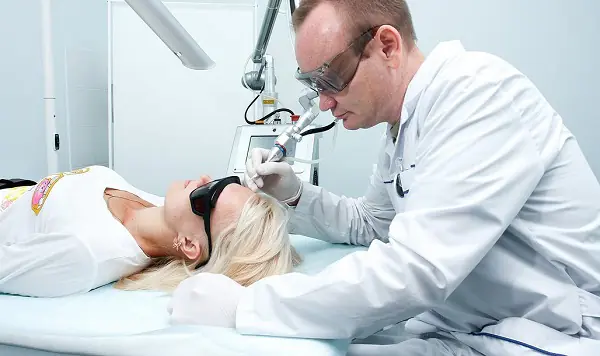
— Surgical removal - This is another way to remove a mole on the head. With this operation, not only the mole is removed, but also 3-5 mm of skin around it. The disadvantage of this method is the formation of a scar at the site of removal. However, if the mole on the head is large enough, then most often experts prescribe surgical excision.
— Cryodestruction - a method using liquid nitrogen, which freezes and destroys the tissue of the mole, which leads to the death of the neoplasm. The most obvious disadvantage of this method of removal is the scars and scars after the procedure.
— Electrocoagulation – here high-frequency current is used to remove moles. The tumor is literally burned out, leaving a wound after the procedure that requires healing. In most cases, electrocoagulation leaves a scar.
— Radio wave method - This is the use of high frequency radio waves. The procedure is similar to surgical excision, however, it is less traumatic for the tissues of the scalp.
The doctor chooses the method of removing a mole based on the individual characteristics of the patient, the shape and location of the mole.
Medical expert article
Every person has moles on their body from the moment of birth, which have different colors and sizes. Initially, they are all benign formations that do not threaten health, but in some cases they can degenerate into malignant ones.
[1], [2], [3], [4]
ICD-10 code
Causes of a pink mole
A pink mole occurs as a result of a disturbance in the functional activity of capillaries and vessels that supply blood to the skin. This mole includes many microscopic vessels, and it can appear on any part of the human body. They are found mainly in adolescents or children - this is probably due to the fact that it is in childhood that the circulatory system undergoes some changes.
Similar moles can also appear in adults as a result of prolonged exposure to sunlight. They are able to grow in various layers of the skin and parts of the circulatory system - capillary, arterial, venous.
The reasons for the appearance of pink moles may be hormonal changes that have begun in the body. Some experts also believe that their occurrence may be the result of a gastrointestinal tract disease (often the pancreas).
Another reason is too intense functional activity of blood vessels, or a deviation in the activity of pigment cells that carry out the process of skin pigmentation.
Thus, if you notice a pink mole on your skin, you can go to the doctor for preventive purposes - this will avoid possible complications.
[5]
Pathogenesis
Moles that are pink in color are also called angiomas and are considered completely benign. They are of vascular origin and mainly appear in children. Although it is not uncommon for a pink mole to grow in adults.
Doctors are not too concerned about this phenomenon, because such moles are not at all dangerous to the body, and also do not affect either its biological processes or overall functional activity.
If we talk about children, the pathogenesis of their pink moles is quite specific - they are able to appear and disappear regardless of external factors and any influence.
Pink nevi can grow in any layer of the skin - they appear in capillary, venous, and arterial areas. These moles will differ in appearance, depending on where they are located. Therefore, they also need to be treated in completely different ways.
Typically, moles of this type appear as a result of a disorder in the capillary vascular compartment. They arise from vascular cells and grow inside the skin layer.
On the surface, a person sees them as small convex pink moles or small red formations. Among congenital benign tumors, these types of angiomas are considered the most common.
[6], [7], [8], [9], [10], [11], [12], [13]
Symptoms of a pink mole
A pink mole forms on the skin from capillaries. This is a benign formation that is not life-threatening. Among its main symptoms are the following:
- Red dots that form on the skin right from the moment of birth or appear throughout life;
- A reddish rash that makes the skin appear like blood vessel markings;
- With their appearance, the state of health does not deteriorate, and the temperature does not rise.
Simple pink moles often form on the body unnoticed by a person; they do not affect the body in any way and do not worsen health. If you have any concerns about the condition of the mole, you need to see a doctor - he will be able to make an accurate diagnosis.
Pink raised mole
A pink mole is also called angioma. It is a benign tumor that forms from blood vessels (capillaries). Such moles are very common on the body - about 22% of all nevi on the skin are pink or red moles.
Such reddish dots appear due to a congenital malformation of blood vessels. They occur in babies, from the moment of birth.
These nevi can have a variety of shapes - either completely flat or slightly convex. The sizes can also vary significantly - there are very small pinkish or red dots, and huge spots that can even occupy the entire arm or leg.
Simple, or as they are also called capillary, moles are mainly spots of pink, purple or crimson color. When pressed they turn pale. These moles can be raised or smooth. Some of them look like a formation with a red dot in the center, from which small dilated vessels diverge radially.
A pink, raised mole usually appears in mature or elderly people. It indicates an early stage of skin cancer development (usually squamous cell carcinoma or basal cell carcinoma).
Mole turned pink
Moles become red or swollen when injured. They can also change color due to various diseases.
What to do if a mole turns pink? You should definitely consult a doctor if a mole has changed color, as well as if it changes shape or begins to cause you pain and discomfort. At the clinic, you will be able to undergo a special examination that will help make sure that the formation does not have malignant cells and find out whether it needs to be removed from the body.
It is not recommended to solve the problem with a pinkish mole on your own - you should not use folk recipes or try to remove it yourself. Such home “treatment” can at least lead to infection, resulting in inflammation. In the worst case, you will experience the development of a pathological focus, which will take a very long time to treat, spending a lot of effort on it.
A pink mole that is very painful and bleeds can be removed using a radio knife or laser. It can also be cauterized. A suitable treatment method is prescribed by a qualified doctor, based on examination data, as well as additional diagnostics.
[14], [15]
It's rare to see a person without small dark marks on their body. Is it worth paying attention to these points? Only a doctor will distinguish between dangerous and normal moles - malignant melanoma or harmless nevus - and give recommendations on what to do with them. Is it worth worrying about the appearance of new formations, when immediate contact with specialists is required, what are the signs of cancer development - the answers to these questions remain to be found out. No one is immune from disaster, and early diagnosis will protect you from severe consequences.
What is a mole
The first tiny spots may appear in children in infancy. A mole is a small formation on the skin - a nevus - that is considered benign and harmless. The basis for their appearance is melanocyte cells that accumulate the natural pigment melanin. Depending on its quantity, a difference in color is observed. Available colors:
The shape of the tumors depends on the location and concentration of melanin. They may have a stalk or be located under the skin, be flat and convex. The most common type is round, but there are exceptions. The development of neoplasms is provoked by ultraviolet radiation - natural from the sun, in a solarium. Hereditary factors cannot be excluded. A common cause of growth is hormonal imbalance, characteristic of periods:
- puberty;
- pregnancy;
- menopause.
What types of moles are there?
One person may discover very different tumors. Types of moles are classified according to several criteria. This helps in correct diagnosis in case of changes. They differ in:
- origin– congenital, newly acquired;
- structure– pigment, vascular;
- place of education – in depth, on the surface, in the boundary layer;
- raised above the skin – flat – even, protruding as a hemisphere, pedunculated, larger birthmarks;
- potential threats – dangerous, degenerating into melanoma, non-dangerous.

Safe moles
Those who have dark spots on their skin should be wary of their changes. In time, detected signs of degeneration into melanoma contribute to the timely removal of the formation and preservation of health. Safe moles are different:
- the presence of a stalk – it cannot be formed by malignant cells that grow randomly;
- long-term condition without changes.
Spots that appear soon after birth are not considered dangerous. It is important that they are small in size. Good – non-dangerous – signs of neoplasms include:
- flesh tone;
- unchanged pattern of the skin of the nevus and adjacent tissues;
- soft consistency;
- hair on the surface of the neoplasm - growing from the skin, indicates the absence of pathologies;
- diameter no more than 5 mm;
- symmetry;
- nevus in the form of a spot.
Which moles are dangerous?
Why do people with nevi on their bodies need to monitor their changes? There is always a threat of degeneration of non-dangerous tumors into a cancerous tumor. What moles are dangerous to health? Key signs you need to know:
- change in shades towards the dark side, the appearance of multi-color;
- rapid increase in size - exceeds two millimeters per year;
- occurrence of cracks;
- the formation of asymmetry due to uneven growth;
- lack of elasticity;
- the appearance of itching, burning;
- presence of discomfort.
The appearance of dangerous moles requires an immediate visit to a specialist to clarify the nature of the changes and the likelihood of developing skin cancer. Pathological transformations provoke:
- injury to the nevus due to negligence;
- self-removal;
- abuse of exposure to the sun, use of a solarium;
- location of the formation in places of frequent contact with clothing - on the neck, head, genitals, legs;
- placement in the hair, on the face, palms - where there is a high probability of injury;
- previously removed melanoma.
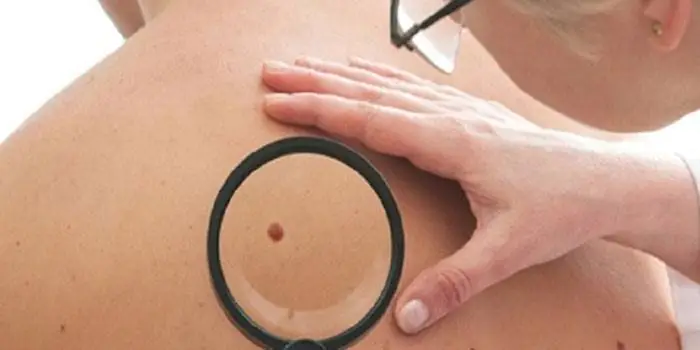
Why are moles dangerous?
Not a single person is protected from the sudden proliferation of cells of a harmless mole. Melanoma is an extremely serious disease. Changes not detected at the initial stage can result in death. The provoking factor is unsuccessful independent removal of tumors. Moles are dangerous because of their ability to:
- transform into an atypical – precancerous form;
- grow to large sizes;
- turn into cancerous;
- with minor external changes, metastases actively spread throughout the body through the circulatory and lymphatic channels.
How quickly does melanoma develop from a mole?
The transformation of a nevus into a cancerous formation can occur in different ways. The process depends on the stage of the disease and the type of tumor. Instant metastases are dangerous. Begins:
- growth of cancer (oncological) cells in the deep layers of the epidermis;
- their entry into the blood and lymph;
- penetration into the lungs, liver, kidneys;
- growth in these organs;
- complete damage to the body;
- death.
The growth phases of pigment cells are observed, along which melanoma develops from a mole. There are varieties:
- horizontal– damage to the upper layers of the skin occurs, lasting up to 10 years, but metastases do not appear;
- vertical– accompanied by the spread of cancer cells throughout the organs, can last two years, has an unfavorable prognosis;
- nodal – especially dangerous – characterized by deep spread within two months.
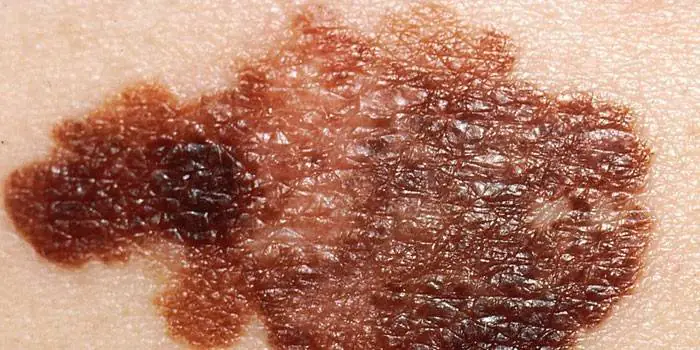
The first signs of melanoma
The patient can be assisted only when suspicious changes begin to be identified. The diagnosis, research, and referral for surgical treatment save a person’s life. The first signs of melanoma:
- increase in the height of the tumor;
- bleeding;
- the appearance of discharge;
- redness;
- burning, itching;
- swelling of tissues;
- softening of the nevus;
- the appearance of a crust;
- thickening;
- hair loss;
- expansion of pigmentation around the lesion.
With the further development of dangerous melanoma, the following are observed:
- significant change in size;
- the appearance of pain;
- enlarged lymph nodes;
- surface ulceration;
- formation of new foci;
- bleeding from places of pigmentation;
- liquid separation;
- skin thickening;
- the appearance of an earthy tint;
- signs of metastases are chronic cough, weight loss, cramps, headaches.
How to distinguish a mole from melanoma
To recognize which moles are dangerous and which are not dangerous, you need to know what they look like. A person with nevi, in order to eliminate terrible consequences, must constantly monitor the appearance of new formations and changes that occur. You can distinguish a mole from melanoma by its signs. Non-dangerous neoplasm:
- symmetrical;
- with smooth edges;
- uniform in color;
- with dimensions not exceeding 6 millimeters.
Features of dangerous melanoma that require seeking help from dermatologists:
- growth in a short time;
- pronounced asymmetry of shape;
- heterogeneity in color - the presence of inclusions of several shades;
- lack of clear boundaries - the contour line is blurred, jagged, and looks like a coastline on a geographical map;
- increased diameter over six millimeters;
- variability of any parameters - color, size, shape.

What dangerous moles look like
What do nevi that are subject to pathological changes look like? Only a doctor can correctly distinguish between non-dangerous tumors. Dangerous formations look like this:
- blue– compactions under the skin with clear boundaries, with dimensions no more than 10 mm;
- nodal– round, flat in shape, color – brown, black;
- cutaneous– often pale, convex;
- halo nevus – pigment surrounded by a light or white rim;
- spitz- looks like a dome-shaped tumor of pink shades, with the possible presence of a hole through which blood and liquid leak;
- connecting- connect individual entities into a whole.
Mole with jagged edges
One of the signs of a non-hazardous formation turning into a dangerous one is a change in contours. It often has blurred edges and scalloped borders. There are non-dangerous types of nevi - dysplastic. Only a specialist can make a correct diagnosis. A mole with uneven edges can be dangerous if there are additional signs of melanoma:
- accelerated changes in size;
- the presence of clearly defined asymmetry;
- the appearance of highly indented boundaries.
Rough mole
Such a neoplasm is harmless if its diameter is no more than 5 mm and remains constant in size. Often its appearance signals a lack of vitamins and nutritional disorders. Doctors advise coming for a consultation if it is discovered that:
- the smooth nevus turned into a rough one;
- bothered by burning, itching, tingling;
- irregularities and compactions appeared in the middle;
- areas with different shades formed;
- diameter has increased significantly.
A dangerous rough mole requires immediate examination if:
- the appearance of bleeding;
- development of the inflammatory process;
- rapid change in size;
- formation of asymmetry;
- formation of purulent discharge;
- the occurrence of painful sensations when touched;
- the emergence of an irregular shape, blurred boundaries, along the edges of the neoplasm.
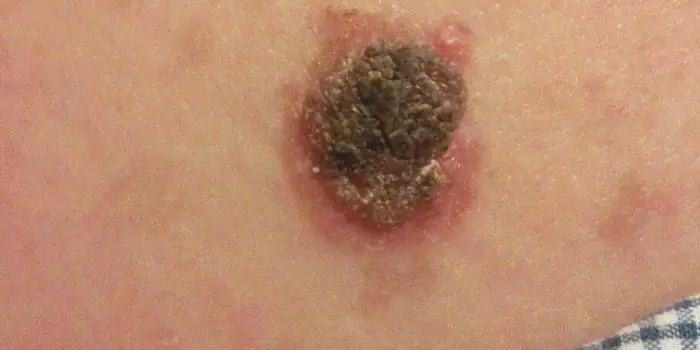
Large moles
Large formations on the skin are pigment spots. When they remain unchanged and do not cause inconvenience, this is a harmless phenomenon. It is important to constantly monitor their appearance, color, and size. To eliminate worries, you need to consult a dermatologist. During the visit, the specialist will conduct a diagnosis and give a forecast of the risk of developing a malignant neoplasm. Large moles become dangerous if they:
- injured;
- thickened;
- started to itch;
- were unsuccessfully removed independently;
- changed in size, shape;
- are bleeding.
What moles can be removed
Often nevi cause trouble for women when they are in a visible place - the face, neck. Even if they do not bother you, using removal will be the right decision - the appearance will improve significantly. After the procedure, the doctor must send the tissue for histological analysis to decide whether the mole is malignant or not. If the neoplasm is not dangerous, does not bother you, and does not change in size, surgery is not required. What moles cannot be removed? Experts believe:
- there are no contraindications;
- It is important to choose the right excision technique.
You should be careful about skin growths; it is unacceptable to remove them yourself. Only the doctor will determine whether a nevus is dangerous or not and decide what to do with it. You can delete it if:
- injured from clothing - on the neck, in the groin area, under the armpits;
- cause pain when touched;
- are located under the hair on the head and can be damaged when combing or cutting;
- change color, shape, outline;
- significantly increase in size;
- characterized by the presence of burning, itching;
- accompanied by inflammation and bleeding.



